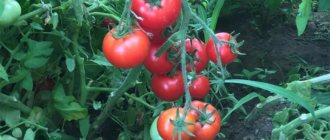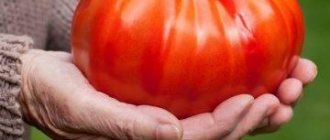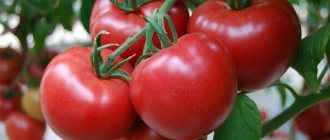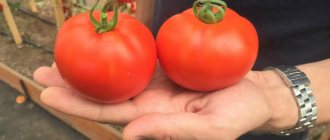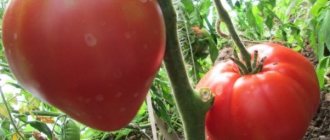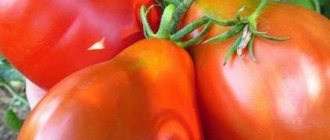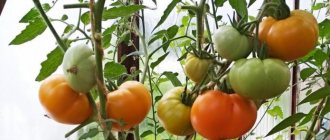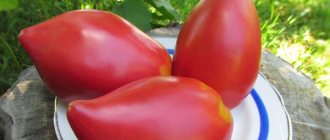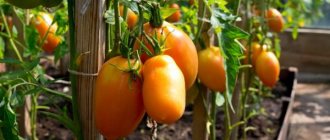Tomato Honey Drop f1 is a popular variety of cherry tomatoes that adults and children adore. Small teardrop-shaped or pear-shaped fruits can be enjoyed instead of summer fruits; they look very beautiful when preserved and decorate salads and sandwiches.
| Height | Landing location | Ripening time | Fruit color | Fruit size | Origin | Fruit shape |
| Tall | Greenhouse, Open ground | Mid-early | Yellow | Small | Variety | Pear-shaped |
Description and characteristics of the variety
There are several varieties of seeds on the market - Honey Drop tomato from Gavrish and Honey Drop tomato. On the packages of the second one there is sometimes the mark f1 - a sign that this is a hybrid. However, gardeners who grew both species claim that this is not a hybrid, but a variety, and the bags contain the same seeds.
The height of the Honey Drop tomato in a greenhouse reaches two to two and a half meters; it is an indeterminate plant. The bush is not standard. Sometimes in the beds you can find the low-growing Honey Drop tomato, but this is not a separate subspecies, but simply the same variety, planted in open ground, where it grows to only 1.2-1.5 meters.
The leaves on the bush are large. The fruits grow in clusters and ripen in the mid-early period.
Description and characteristics of the fruit: cherry tomato Honey Drop produces small tomatoes weighing 15-20 g, the largest reach 30 g. They are pear-shaped and bright yellow in color. The taste is sweet, has a slight honey flavor. Inside there are a small number of seed chambers and some seeds.
These tomatoes have a lot of vitamin A and sugar, the pulp is light and dietary.
The fruits are used for fresh consumption, preparation of soups, stews, lecho and slices, processing into juices and pastes, whole canning and pickling, as well as for decorating holiday dishes.
How to grow seedlings
To get a good harvest, you need to carefully consider the choice of seed and soil preparation.
Seed preparation
Before you go to the store to buy seeds, carefully study the information from the manufacturers. It would be a good idea to ask your gardener friends which suppliers they prefer. Seeds must be disinfected before planting. Solutions of “Bud”, “Zircon” or any other growth stimulant will come to the rescue. You can also use proven folk remedies, for example, aloe juice.
Next, the material must be germinated. To do this you will need a cotton pad and a small plate. Unfold the disk and place the seeds on it. Cover the top with damp gauze and place it on a plate. Make sure that the seeds do not dry out. Experienced gardeners also advise adding aloe juice to the water.
Container and soil
It’s easy to prepare the soil yourself. To do this you will need garden soil, humus, peat and ash. When the mixture is ready, it should be disinfected. A solution of potassium permanganate is suitable for this.
If you buy ready-made soil, you should also make some efforts to enrich the soil with useful elements. The fact is that the main substance in purchased land is peat. It does not allow water to pass through well and is highly acidic, so such soil is sometimes not suitable for growing seedlings. To eliminate the problem, it is recommended to add dolomite flour or chalk to the soil. This will reduce the acidity level and make the soil more suitable for growing seedlings.
Sowing
When the container, soil and seeds are ready, start sowing. Make holes at a distance of 3 cm from each other, place seeds in them and sprinkle soil on top. Water the seedlings generously with warm water, place in a warm, bright place and cover with thin glass or film. This will create a favorable microclimate for germination.
Growing and care
First of all, pay attention to the air temperature. The optimal temperature is about 23 degrees. As soon as the first shoots appear, place the container in a cooler place
Gradually open the film slightly. It is recommended to remove it completely after 2 weeks from the moment of planting.
As soon as the first shoots appear, place the container in a cooler place. Gradually open the film slightly. It is recommended to remove it completely after 2 weeks from the moment of planting.
Pay special attention to watering. For the most correct watering, it is recommended to use a pipette or syringe. Make sure the water gets to the base of the sprout and not to the leaves.
Under no circumstances should you water the seedlings with cold tap water. Otherwise, the bushes will become infected with root rot.
Make sure that the water gets to the base of the sprout and not to the leaves. Under no circumstances should you water the seedlings with cold tap water. Otherwise, the bushes will become infected with root rot.
Remember that Honeydrop loves a lot of light. If there is a lack of sun, it is recommended to create additional lighting for the bushes using phytolamps.
After 10-15 days from the moment of planting, the first feeding should be organized. An excellent option for this is potassium superphosphate or ammonium nitrate. Apply the last fertilizing 10 days before planting the seedlings in the ground.
Features of cultivation and storage
It is recommended to plant tomatoes in greenhouses, since in the middle zone and to the north it does not have time to ripen in open ground. But in southern climates you can plant it outdoors. Bushes must be tied to supports.
The originator recommends pinching the plant and growing it into 2-3 stems, but gardeners who grew it note that the yield will be higher if the extra stepsons are not cut off.
The fruits are perfectly stored, do not lose their taste and aroma, and can be transported over long distances.
Disease and pest control
Honey drop is little susceptible to major tomato diseases. Of course, if the plants in the garden are infected with late blight, then this tomato will also suffer. But he rarely gets sick first. Things are worse in the greenhouse, where the variety gets sick more often. Main reasons:
- thickening of bushes and plantings;
- high humidity.
To prevent diseases, the room needs daily ventilation.
Honey drop grows well both in a greenhouse and in open ground
If you plant tomatoes in the same place every year, pathogens—disease agents—accumulate in the soil. To improve the microflora in the soil at the roots of the tomato, it would be good to mulch the plantation with dried hay.
When planting a variety to prevent diseases, it is enough to treat it with a solution of Fitosporin-M once every 10 days. In case of emerging diseases, use copper-based fungicides.
Of the pests, the cutworm and tomato leaf miner are the most annoying to tomatoes. The caterpillars of these butterflies eat holes in the fruits. If the invasion is not stopped, the harvest will suffer. The best means of control is considered to be spraying with the biological product Bitoxibacillin.
The bollworm moth often lays eggs on weeds, so you need to weed your garden regularly
Folk remedies for armyworms and moths only work as a preventive measure. To prevent butterflies from entering the garden, the plants are treated with a decoction of garlic.
Preparing a remedy for caterpillars:
- Boil 300 g of garlic in 3 liters of water for an hour.
- Filter, bring the volume to 10 l.
This product also repels other tomato pests.
I grew Honey Drop for two years in a row, but gave it up. A friend, presenting seeds of this variety, called it pampering and added: plant no more than two bushes. Now I understand why. The fruits turned out to be too small for such a huge bush, although I planted it. But the green mass also removes a large amount of nutrients from the ground. It takes a long time to make a salad from trifles, because I cut out the places where the stalks are attached. The tomato is not suitable for juice: the small seeds quickly clog the strainer of my juicer. If you add it to preserves, you need a little fruit for beauty, because their pulp is too watery. True, one day I was treated to wonderful juice from these tomatoes. I was struck by the unusual taste, as if it was squeezed from exotic fruits. I replaced this tomato with another snack variety - Black Cream. Its fruits are slightly larger, the taste is richer and the yield is higher for the same bush size.
How the Honey Drop variety grows in the garden - video
Productivity
Multi-colored types of tomatoes differ in their qualities from ordinary red tomatoes. Yellow fruits have more pulp and are sweet in taste. The amber coloring of Honey Drop tomatoes is associated with the presence of provitamin A in the fruit. Lycopene is useful in preventing the development of malignant tumors. The action of the myocin enzyme in yellow tomatoes is aimed at strengthening the walls of blood vessels and activating the action of antioxidants in the human body.
Since honey-colored fruits contain B vitamins, after consuming them a person becomes calm, his sleep is normalized, and digestion processes are restored. Yellow tomatoes have a positive effect on the condition of the hair, skin, and nail plate. Eating tomatoes of this variety will have an effective effect on visual acuity.
Honey Drop tomatoes will delight you with small fruits, weighing from ten to twenty grams. In shape they resemble a miniature pear of rich yellow color. The tomato droplets taste pleasant and sweet. The fruits contain little water and more pulp. You can quickly get enough of them; it’s not for nothing that Honey Drop tomatoes are recommended for dietary nutrition.
The Honey Drop variety produces many excellent small fruits that are bright yellow in color and resemble honey or amber drops or small pears.
Small-fruited variety “honey drop”
The taste of tomatoes is sweet with characteristic notes of honey. Small chambers with seeds are formed in the juicy pulp.
The fruits are eaten fresh, vitamin-rich salads, side dishes, soups and juices are prepared from them. Yellow tomatoes look great when canned, dried, or pickled. For special gourmets, there are recipes for “honey drop” tomato jam.
Tomatoes of this variety can remain fresh and marketable for several months. The fruits can ripen outside the bush. This is convenient when finishing the harvest in the fall.
Thanks to their amazing sugary taste, the fruits are a big hit among children. Miniature honey drops can decorate the most exquisite holiday table, sometimes they are even served as dessert. However, the “Honey Drop” variety is capable of solving other culinary problems:
- Whole-fruit canning (canning is very convenient due to the small size of the fruits);
- Preparation of heat-treated dishes (soups, borscht, side dishes);
- Processing into juice, tomato paste, lecho;
- Barrel salting.
“Honey Drop” pleases the gardener with fresh fruits until the first days of October. 2-3 kg of selected, proportionate fruits are harvested from one plant.
The variety is intended for cultivation in all regions of the Russian Federation.
In the south, where summers are quite long and warm, seedlings can be planted in open ground. In other areas, "Honey Drop" is grown under shelters.
The honey drop begins to ripen 100 days after planting. This variety of tomatoes is used for pickling (but not pickling), preparing salads, drying, and eating when ripe. Honey drop is an ideal tomato for allergy sufferers (they often have undesirable reactions to red fruits) and people with high acidity of gastric juice.
The yield of the variety is high, like the Carpal tomatoes, and the taste is good if the growing conditions are met. One bush produces an average of up to 2 kg of fruit. To increase productivity, fertilize and water the plants in a timely manner. You can pick tomatoes before they are fully ripe.
Tomato variety “Honey Drop” ripens 100 days after planting
From 1 bush you get about 2 kg of fruit.
Tomato care Honey drop
Activities for caring for tomatoes in the ground are generally similar to caring for seedlings.
Watering
Watering should be done at least once a week, but not more often than the top layer of soil dries out. Since the skin is very thin, water should not fall on the fruits or leaves, but should be directed to the base of the stem.
Feeding
The plant requires feeding 3 times in one season - when transplanting into the ground, so that the plant quickly takes root in a new place, in the middle and at the end of flowering. Nitrogenous fertilizers and mixtures of potassium and phosphorus are used for feeding.
The stepsons of the “Honey Drop” grow very intensively, as a result of which they need to be removed. This procedure is carried out as the stepsons grow by cutting them at the base. The bush is formed into one stem, and all excess shoots are removed.
Disease resistance
The overall level of disease resistance of tomatoes is assessed as average, but experts note that one of the disadvantages of this type of tomato is its weak resistance to some diseases. But with proper care and compliance with planting rules, the development of diseases can be prevented.
Attention should also be paid to disease prevention. When the first signs of any disease appear, in particular such as late blight, you should immediately treat
Both diseased and healthy leaves are sprayed with a special solution. This will stop the development of the disease and prevent infection of neighboring bushes.
To prevent tomato diseases, fungicidal drugs such as Ridomil are usually used. The following should also be used as a preventative measure:
- Compliance with watering rules - try to water only the soil, water should not get on the leaves.
- Treatment of leaves with a solution of Bordeaux mixture.
- Tomato bushes should be planted separately from potatoes.
- When gray rot appears, immediately treat with fungicidal preparations. They are suitable for both treatment and future prevention. A wide range of modern fertilizers allows you to choose a harmless and effective option.
As soon as diseased leaves or stems appear, they should be disposed of to stop the spread of the bush disease.
Advantages and disadvantages
The Honey Drop variety belongs to the same group as cherry. This variety of tomatoes forms bushes of impressive size, which when grown in open ground reach 1.5 m, and in greenhouses - 2 m. Each branch bears from 10 to 15 fairly large fruits. Often their weight ranges from 12 to 15 g, but there are tomatoes weighing 30 g.
Among the main advantages of the variety:
- it can be propagated by seeds that were collected from ripe tomatoes;
- the number of sprouted seeds reaches 95%;
- tomatoes have a pleasant taste and aroma;
- they are suitable for fresh consumption and for storing for the winter;
- The plant is characterized by high productivity.
Sweetish tomatoes are very tasty fresh. With their bright color they will decorate any salad and become an indispensable part of the side dish. These tomatoes are added to juices and soups. Amber fruits in jars look no less beautiful. Especially if you preserve small red and yellow tomatoes at the same time.
Honey drop has its drawbacks. Due to their tall growth, the bushes require pinching. Tomatoes should be tied to a stable support, watered in a timely manner, do not forget to feed them, and also planted in soil suitable for them.
To get a good harvest, seeds for seedlings are sown in the first week of March. Grown plants are transplanted into a greenhouse or open beds at the end of spring or early June.
Honey drop is quite demanding on the substrate. For it you need to take only nutritious soil. The best option is light soil made from a mixture of earth and sand, supplemented with compost. Once every 7-9 days, the beds should be weeded, getting rid of weeds and loosening the soil. In order to speed up the process of grain germination, it is recommended to add fertilizers based on potassium and phosphorus compounds to the soil.
Due to the fact that Honey Drop is very picky about soil, in a greenhouse for its cultivation it will be necessary to replace the top layer of soil every year.
In order to grow a young plant, you can use both purchased and independently collected seeds from ripe fruits. To prepare planting material, just cut the tomatoes, grind the pulp through a sieve and rinse thoroughly under running water. The resulting seeds are dried on paper or a napkin. Then they are collected in paper bags and stored in a dark place, making sure that insects or rodents do not get to them.
Planting seeds
Before you start sowing seeds, they must be treated with a solution of hydrogen peroxide or potassium permanganate. After this, the grains are placed in a moist soil mixture, deepened by about 2 cm. The containers are covered with polyethylene until the first shoots appear. Seedlings should be grown at a temperature of 22 - 250 C. After a week or 10 days, young shoots should appear from the ground.
After the first leaves appear, the plants need to be pruned. Containers with seedlings are well watered, then each specimen is planted in a separate container (pot, container, glass). When picking tomatoes, it is recommended to slightly shorten (pinch) the main root. This will allow the root system to develop correctly and form many new roots. When planting, the stem of the plant is deepened into the soil up to the lower leaves.
Before planting seedlings in their permanent place, young plants should be prepared for new conditions - hardened off. To do this, boxes with tomatoes are taken out into the fresh air for several hours. They are planted in the greenhouse at the end of May. If you plan to grow Honey Drop directly in the garden, then planting is carried out at the very end of May or even at the beginning of June.
Honey Drop tomatoes should be planted according to a 40 x 70 cm pattern. But the distance between the rows of tomatoes can be reduced to 40-45 cm. This will not affect the yield, the number of fruits will not decrease, but this approach will significantly save space on the site.
Watering and fertilizing
Tomatoes of this variety require regular, systematic watering. It is best to carry out the procedure once every 6-7 days. Water for irrigation must settle and warm up.
As fertilizer, you need to use compositions that include organic matter and various minerals. Before application, the granules are diluted in water at room temperature. Seedlings both in greenhouses and in beds need to be watered once every two weeks.
To prevent the bushes from breaking, it is necessary to install special supports. Both greenhouse and garden specimens are tied up. Vertical or horizontal trellises are installed in the greenhouse. In garden beds, tomato bushes are shorter in height, so they are tied to a net or wooden pegs.
Also, do not forget about the formation of plants. To get a good harvest, 2-3 stems are left on the bushes and the rest are cut off.
The Honey Drop variety has many advantages and only minor disadvantages. Therefore, this type of tomato is very popular among summer residents.
Tomatoes of the “honey drop” variety are the result of the work of domestic scientists and breeders; they were bred specifically for cultivation in greenhouse conditions. Suitable for various regions of Russia: in the south it is cultivated in open ridges, in the temperate zone - in greenhouses, closer to the northern regions - in greenhouses.
Sunny variety “honey drop”
The variety ripens in the middle and early periods: from the second half of July to September. The tomatoes are bright, yellow and small, ripen up to 15 pieces on one bunch, each weighing about 15 g. The maximum possible weight is 30 g. The shape of the fruit resembles small pears or droplets. Honeydrop is a variety of cherry tomato.
Indeterminate bushes are not standard, liana-like, grow up to 2 m in height. It is recommended to form the bush into two or three stems after the first brush. They need regular pinching and rigid supports with garters. The leaves that create the green mass are large, potato-shaped.
The tomatoes demonstrate excellent tasting qualities. The taste is sweet, the flesh is juicy and tender.
The variety is very resistant to major diseases: late blight and blackleg. Immunity will keep the bushes from becoming infected, even if there are sources of these diseases around. In open beds, tomato bushes are more resilient.
The bushes do not require abundant watering, ideal quality for our mid-latitudes.
High yield of “honey drop”
The value of the variety lies in the ability to collect your own seeds for the next season, because it is not a hybrid. Ripe, high-quality fruits are rubbed through a strainer; the seeds must be dried and stored in paper bags until the next season in a dry place. You can prepare seeds in this way for 5–7 years in advance.
Let us describe the “honey drop” variety according to its main characteristics:
- mid- and early-ripening variety;
- bushes are indeterminate, tall, not standard;
- productivity is high;
- the ability to independently prepare seed material;
- high tasting qualities of fruits.
Let us list the positive qualities of the “honey drop” variety:
- high seed germination;
- excellent taste;
- wide range of fruit uses;
- excellent yield volumes;
- the ability to prepare seeds yourself.
Ripening of the “honey drop” fruit outside the bush
The existing disadvantages of the variety are as follows: it is necessary to ensure careful removal of stepsons, reliable supports for support, and careful fertilization of the soil.
The “honey drop” variety has excellent immunity to the main common diseases: late blight of leaves, stems, fruits; bacterial molds, black leg, gray rot. Tomatoes get sick more often in greenhouses.
Spraying with soapy water, a solution of hydrogen peroxide or celandine will help against pests.
Growing a Honey Drop tomato has a number of advantages:
- 100% germination of seed material;
- high yields;
- excellent taste;
- resistance to many diseases.
An inconvenience for growing the Honey Drop variety is the high growth of bushes that require staking. Otherwise, productivity depends on proper care.
Reviews about the Honey Drop tomato can only be heard positive. Despite the effort required to care for the plant, it produces tasty fruits for a long time. The versatility of using the variety, the good keeping quality of the fruit, and the preservation of the presentation of the vegetable product after transportation are attractive.
When the seedlings take root, you can lightly loosen the top layer of soil and feed with mullein infusion or manure. The next fertilizing with fertilizers containing nitrogen should be carried out at the beginning of flowering - nitrogen promotes the growth of green mass. A third fertilizing with fertilizers containing magnesium sulfate is necessary during fruit formation.
Honeydrop tomato bushes grow tall and produce a large number of side shoots that must be removed, leaving only 2-3 to form stems. You need to remove shoots once a week as they grow, leaving small stumps so that a new one does not grow in this place.
Throughout the season, periodically remove every third leaf to avoid excess green mass. In August, in the middle of the month, pinch off the top and remove the flowers, since the newly formed fruits will not ripen.
Water tomatoes once every ten days in spring, and more often in summer - once a week. You need to water at the root, without exposing it, trying not to pour water on the leaves, so as not to create excessive humidity in the greenhouse.
Mulch (grass, hay, sawdust, pine needles) between the rows retains moisture, which allows for less frequent watering, is an additional source of nutrients and prevents the growth of weeds.
To protect against infections, treat seedlings with Fitosporin, and then adult plants several times a season.
The Honey Drop tomato variety is interesting for growing due to its appearance, original taste and will not disappoint in various uses.
Pros:
- great taste;
- nice decorative appearance;
- good yield;
- versatility in use;
- excellent seed germination;
- planting material can be prepared independently.
Minuses:
- painstaking care;
- increased demands on soil quality and fertilizing.
Planting seedlings in a permanent place
This event is held at the age of 65 days. Tomatoes are placed according to a 50x60 cm pattern with a distance of 10 centimeters between bushes in the same row and 12 centimeters between the rows themselves.
Important! The Honey Drop variety is highly sensitive to crop rotation, so these tomatoes grow better in areas that were previously grown with carrots or legumes.
There should be no more than 4 bushes per 1 m².
Tomatoes: advantages and disadvantages
- Exotic appearance;
- Honey taste;
- High yield;
- Unpretentiousness;
- Possibility of transportation over long distances;
- Universal application;
- No tendency to degenerate the seed fund.
Among the disadvantages of the variety are the following:
- Tall bushes need proper care, including pinching and tying to supports;
- Fruits picked from the bush untimely have a tendency to crack.
